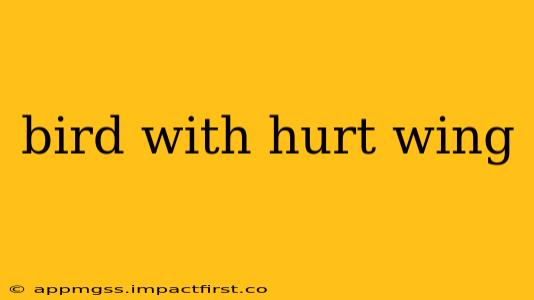Finding a bird with a hurt wing can be distressing. These magnificent creatures are vital parts of our ecosystem, and seeing one injured evokes a strong desire to help. This guide provides comprehensive information on how to approach this situation ethically and effectively, maximizing the bird's chances of survival and recovery.
Is the Bird Actually Injured?
Before rushing to intervene, it's crucial to assess the situation accurately. Sometimes, a bird appearing weak or grounded may not be injured at all. Young birds, for instance, often leave the nest before they can fly properly, appearing clumsy and vulnerable. Similarly, exhausted birds may temporarily rest on the ground. Observe the bird for a few minutes from a safe distance. Is it trying to fly and failing? Is there any visible injury like bleeding, a broken bone, or a deformed wing? If you're unsure, it's always best to err on the side of caution.
What Should I Do If I Find a Bird with a Broken Wing?
If you've determined the bird is indeed injured, your next steps are crucial. Do not attempt to handle the bird yourself unless absolutely necessary. Wild birds can bite and scratch, even when injured, and you risk causing further harm. Instead:
- Observe from a distance: Assess the bird's immediate environment. Is it in danger from predators or traffic?
- Contact a wildlife rehabilitator: This is the most important step. Wildlife rehabilitators are trained professionals with the knowledge and facilities to provide proper care for injured wildlife. Search online for "wildlife rehabilitator [your location]" to find a local expert.
- Keep pets away: Cats and dogs pose a significant threat to injured birds. Keep them indoors or safely restrained.
- Create a temporary shelter (if necessary): If the bird is in immediate danger, you may consider creating a temporary shelter using a cardboard box lined with soft material. Place the box near the bird, but avoid direct contact. The goal is to provide minimal disturbance and protection until a rehabilitator arrives.
What if I Can't Find a Wildlife Rehabilitator Immediately?
Finding a wildlife rehabilitator quickly is paramount. However, if immediate access is unavailable, you may temporarily provide minimal assistance. This should only be a last resort, and only if the bird is in imminent danger. Remember, improper handling can worsen the injury.
- Provide shade and shelter: Place the bird in a dark, quiet, and secure space to minimize stress.
- Offer fresh water: Provide a shallow dish of clean, fresh water, but avoid forcing it on the bird.
- Do not feed the bird: Feeding wild birds incorrectly can be harmful.
How Do I Care for a Bird with a Hurt Wing at Home?
Under no circumstances should you attempt long-term care of a wild bird at home. Wild birds require specialized care, and home environments are inadequate. This could lead to further injuries, infections, or even death. Focus on contacting a wildlife rehabilitator immediately. Keeping the bird warm and safe from predators until professional help arrives is your priority.
What Are the Chances of Recovery for a Bird with a Wing Injury?
The chances of a bird's recovery depend on several factors, including the severity of the injury, the bird's overall health, and the quality of care it receives. While some injuries are treatable and lead to a full recovery, others may result in long-term disabilities or even death. The expertise of a wildlife rehabilitator significantly impacts the outcome.
Should I Handle the Bird Myself?
Handling a wild bird, even an injured one, is generally discouraged unless you are a trained wildlife rehabilitator. The stress of capture and handling can worsen the bird’s condition, leading to increased injuries or complications. Trust the professionals for the best chance of recovery.
By following these guidelines, you can effectively help an injured bird while minimizing the risks involved. Remember, your role is to provide temporary assistance and contact a wildlife rehabilitator – they possess the expertise to ensure the bird receives the care it needs.
